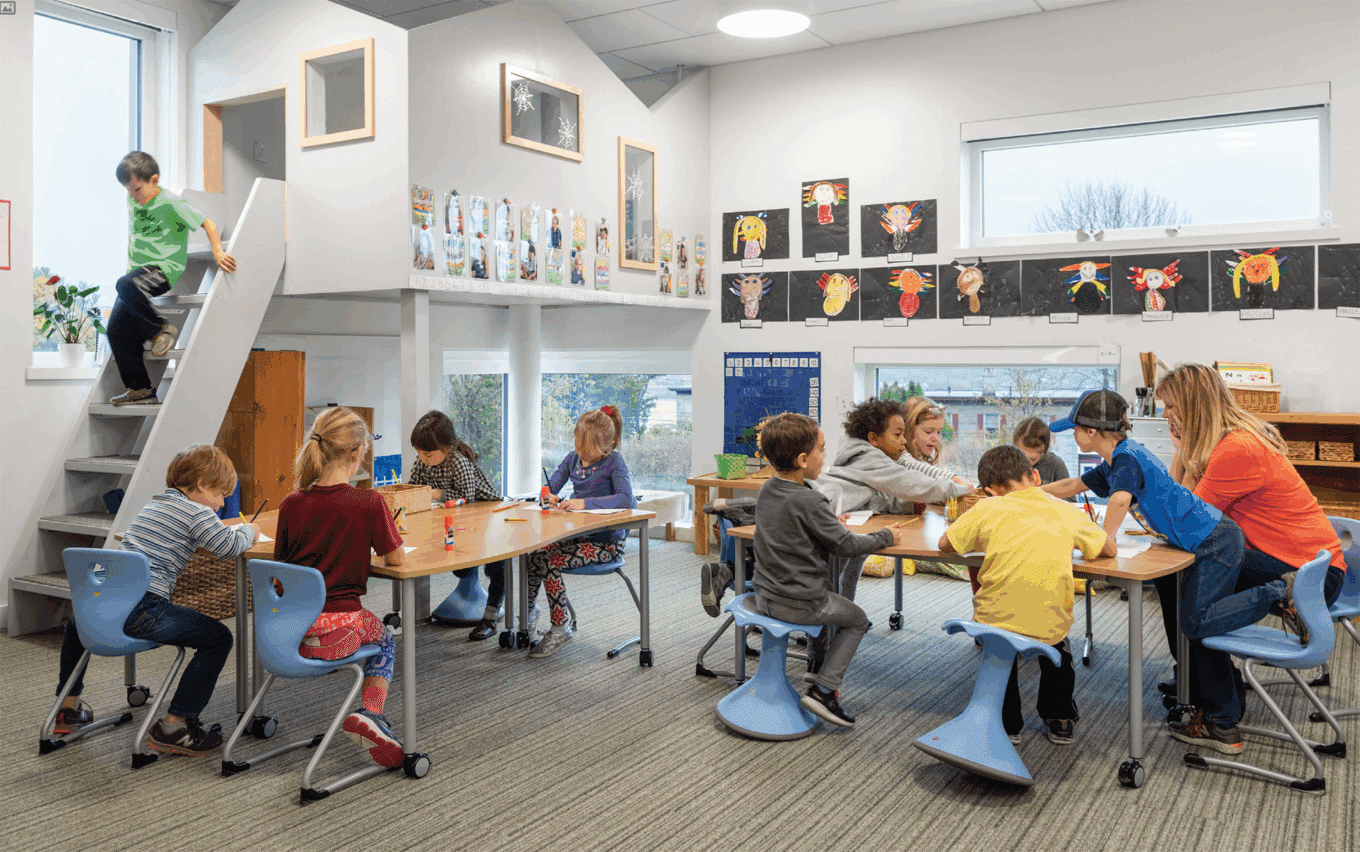Looking for ways to keep your students happy and learning when stuck inside? You’re not alone. Teachers everywhere search for good indoor activities when rain hits or between lessons.
This guide has some tested classroom games that students actually enjoy. You’ll find quick games for energy breaks, calm games for focus time, and team games that build social skills.
Each game comes with simple steps, the necessary items, and the skills it develops. If you teach young kids or older students, or have five minutes or twenty, this list has something that fits your needs.
Let’s find the perfect indoor games to make your classroom both fun and helpful for learning.
Why Indoor Classroom Games are So Valuable
Indoor classroom games do more than just fill time—they actively help students build important skills. These activities boost focus when students start to lose attention.
They also build teamwork as children work together to solve problems or compete in friendly challenges. Many games spark creativity and allow students to think in new ways.
These games are perfect solutions for:
- Rainy days when outdoor recess isn’t possible
- Short brain breaks between lessons
- Class transitions to help students reset their mental energy
- Times when students need to practice social skills
Fun Indoor Classroom Games
Indoor games offer a mix of active and quiet activities that help students learn while having fun.
Active Games to Get the Wiggles Out
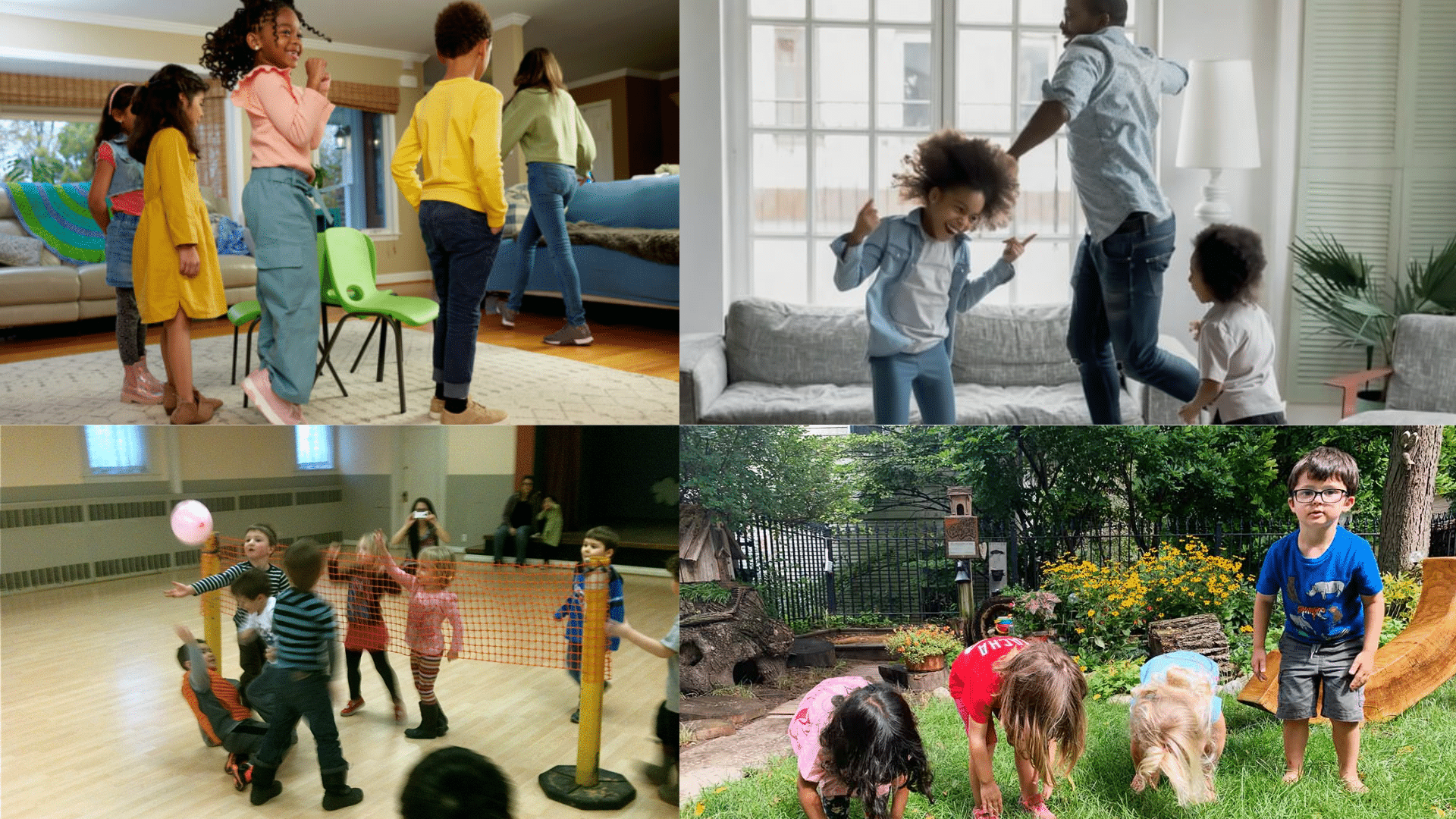
These games help students use up extra energy in a positive way. They keep kids moving while teaching important skills like listening and coordination.
1. Musical Chairs
What it is: A classic game where students walk around chairs while music plays.
How to play: Set up chairs in a circle, one fewer than the number of students. Play music as students walk around the chairs. When the music stops, everyone must sit. The student without a seat is out.
Benefits: Improves listening skills, reaction time, and physical coordination.
Materials needed: Chairs and a music player.
Time required: 10-15 minutes.
2. Freeze Dance
What it is: A movement game where students dance and then freeze when music stops.
How to play: Play music and have students dance. When you pause the music, students must freeze completely. Anyone who moves after the music stops sits down until the next round.
Benefits: Builds self-control, listening skills, and physical awareness.
Materials needed: Music player.
Time required: 5-10 minutes.
3. Balloon Volleyball
What it is: A team game using balloons instead of a regular volleyball.
How to play: Divide the class into two teams with a string “net” between them. Teams hit a balloon back and forth, trying to keep it from touching the ground on their side.
Benefits: Promotes teamwork, hand-eye coordination, and gentle physical activity.
Materials needed: Balloons, string for a net.
Time required: 10-15 minutes.
4. Simon Says
What it is: A following-directions game led by a “Simon” figure.
How to play: One person is “Simon” and gives commands. Students should only follow commands that start with “Simon says.” Those who follow commands without “Simon says” sit out until the next round.
Benefits: Builds listening skills, attention to detail, and self-control.
Materials needed: None.
Time required: 5-10 minutes.
5. Heads Up, Seven Up
What it is: A guessing game that tests observation skills.
How to play: Seven students come to the front. The rest put their heads down and thumbs up. The seven each touch one thumb, then return to the front. Students whose thumbs were touched try to guess who picked them.
Benefits: Builds observation skills and memory.
Materials needed: None.
Time required: 10-15 minutes.
6. Hot Potato
What it is: A fast-paced passing game with music.
How to play: Students sit in a circle and quickly pass an object (the “potato”) while music plays. When music stops, whoever holds the potato is out for that round.
Benefits: Builds reflexes and creates a fun, high-energy activity.
Materials needed: A Small soft object and a music player.
Time required: 5-10 minutes.
Quiet Games for Calm Moments
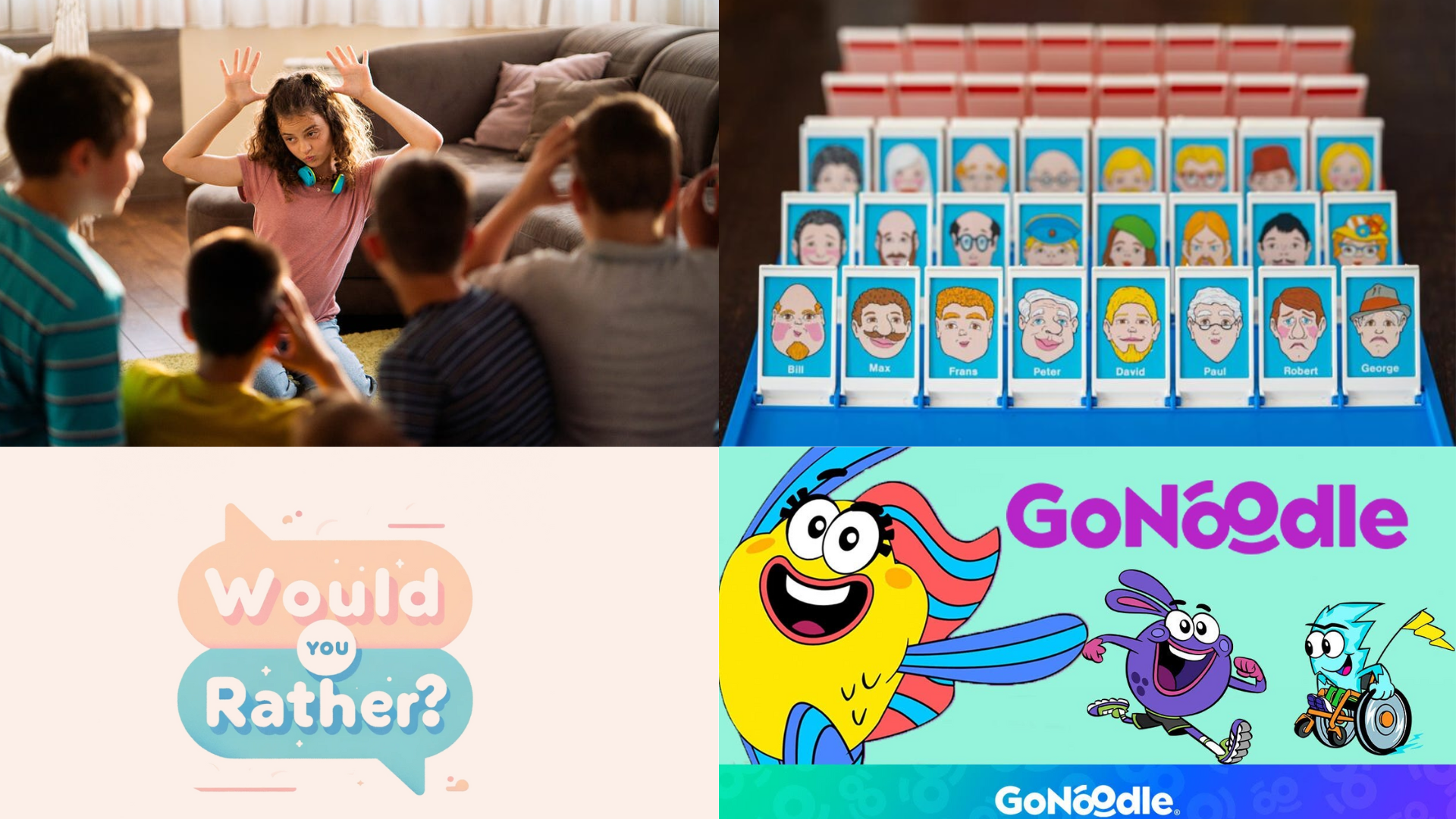
When you need to bring the energy level down while keeping students engaged, these activities strike the perfect balance between fun and focus.
7. Charades
What it is: A silent acting game where players act out words or phrases.
How to play: Students take turns picking a word or phrase from a container and acting it out without speaking, while others guess what it is.
Benefits: Builds vocabulary, non-verbal communication skills, and creativity.
Materials needed: Cards with words or phrases.
Time required: 15-20 minutes.
8. Guess Who?
What it is: A deduction game focused on asking good questions.
How to play: One student thinks of a classmate. Others ask yes/no questions to figure out who it is. Limit questions to 20 or fewer.
Benefits: Builds critical thinking and questioning skills.
Materials needed: None.
Time required: 5-10 minutes per round.
9. Would You Rather?
What it is: A choice-based discussion game.
How to play: Present two options (e.g., “Would you rather be able to fly or be invisible?”). Students move to different sides of the room based on their choice and explain why.
Benefits: Encourages decision-making, speaking skills, and listening to others’ viewpoints.
Materials needed: List of “Would you rather” questions.
Time required: 10-15 minutes.
10. GoNoodle Activities
What it is: Guided movement videos designed for classroom use.
How to play: Play a GoNoodle video and have students follow along with the movements and activities shown.
Benefits: Provides structured physical activity, improves focus, and offers specific movements for different needs.
Materials needed: Computer/projector with internet access.
Time required: 3-5 minutes per video.
11. Yoga Poses Challenge
What it is: Simple yoga poses adapted for classroom use.
How to play: Guide students through basic yoga poses, holding each for 10-30 seconds. Make it fun by having students suggest poses or creating a story around the poses.
Benefits: Improves balance, focus, and stress management.
Materials needed: Space to move, optional yoga cards.
Time required: 5-10 minutes.
12. One Minute Jump Count
What it is: A personal challenge to count jumps in one minute.
How to play: Students count how many times they can jump in place in 60 seconds, trying to beat their own previous record.
Benefits: Builds physical stamina and math counting skills.
Materials needed: A Timer.
Time required: 3-5 minutes.
Team Games to Build Social Skills
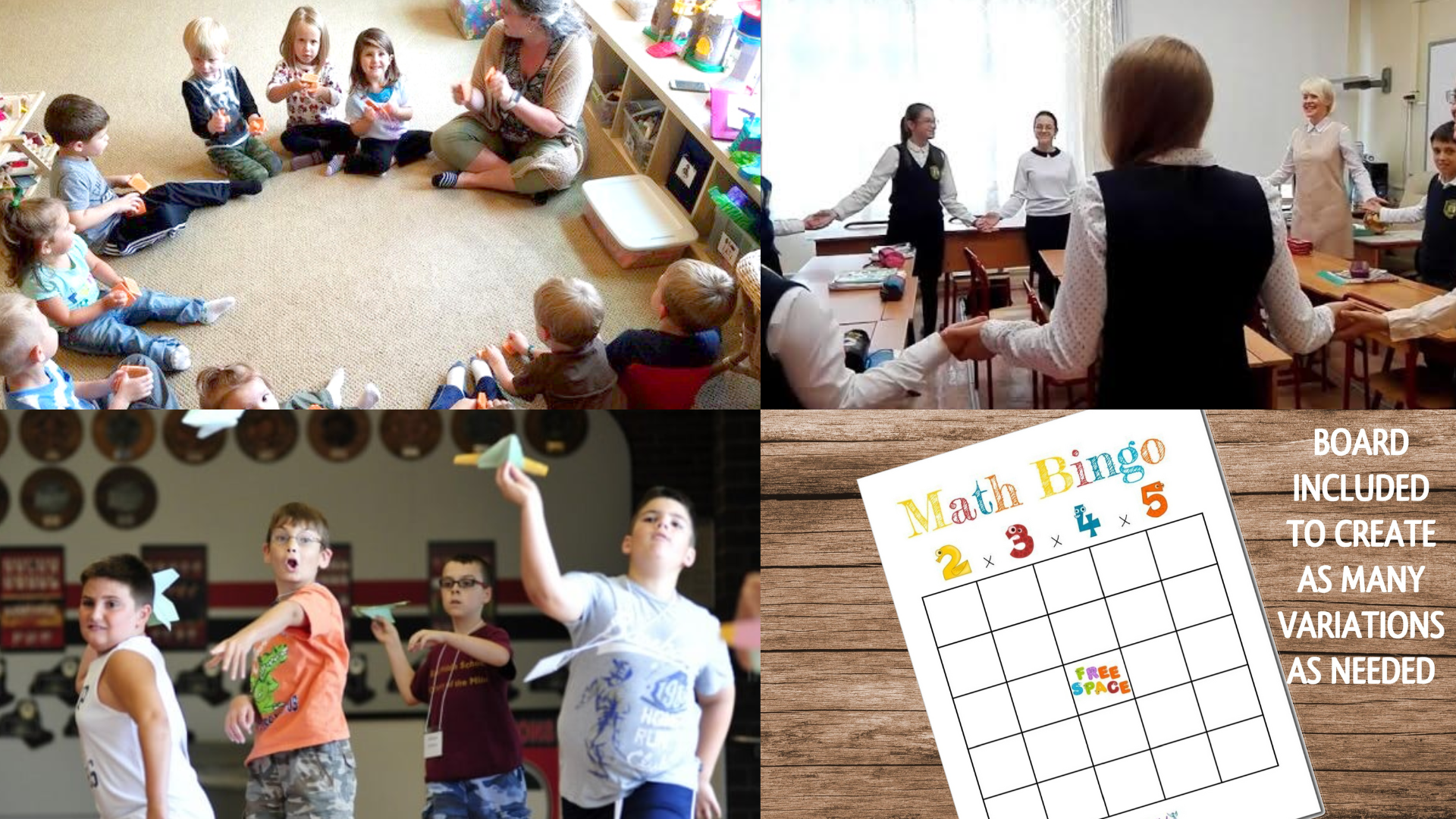
These activities help students practice working together while having fun. They teach key social skills like communication, cooperation, and friendly competition.
13. Group Storytelling
What it is: A collaborative story creation exercise.
How to play: Students sit in a circle. The first student starts a story with one sentence, and each following student adds another sentence, building the story together.
Benefits: Improves listening, creativity, and narrative skills.
Materials needed: None, optional paper to record the story.
Time required: 10-15 minutes.
14. Paper Airplane Contest
What it is: A design and distance competition using paper airplanes.
How to play: Students design and fold paper airplanes, then test whose flies the farthest or most accurately to a target. Allow time for redesigns between flights.
Benefits: Teaches basic physics, design thinking, and perseverance.
Materials needed: Paper, measuring tape, and target markers.
Time required: 15-20 minutes.
15. Pass the Clap
What it is: A rhythm game where a clap pattern moves around a circle.
How to play: Students stand in a circle. The first person creates a clapping pattern that the next person must
repeat, passing it around the circle. Increase difficulty by adding complexity to the pattern.
Benefits: Builds focus, rhythm, and non-verbal communication.
Materials needed: None.
Time required: 5-10 minutes.
16. Math Bingo
What it is: Bingo using math problems instead of simple numbers.
How to play: Create bingo cards with numbers that are answers to math problems. Call out math problems instead of numbers (e.g., “4+5” instead of “9”). Students mark the answer on their cards.
Benefits: Makes math practice fun and gives instant feedback.
Materials needed: Math bingo cards, markers, or counters.
Time required: 15-20 minutes.
17. Spelling Bee Ball Toss
What it is: A spelling game combined with a ball toss.
How to play: Students stand in a circle. When a student catches the ball, they must spell a word, then toss the ball to another student.
Benefits: Combines physical activity with spelling practice.
Materials needed: A Soft ball, a list of spelling words.
Time required: 10-15 minutes.
18. Word Builder Race
What it is: A team game to create words from a set of letters.
How to play: Divide the class into teams. Provide a set of letters (e.g., “THANKSGIVING”). Teams race to write down as many words as possible using only those letters within a time limit.
Benefits: Builds vocabulary, spelling skills, and teamwork.
Materials needed: Paper, pencils, timer.
Time required: 10-15 minutes.
Creative Games for Self-Expression
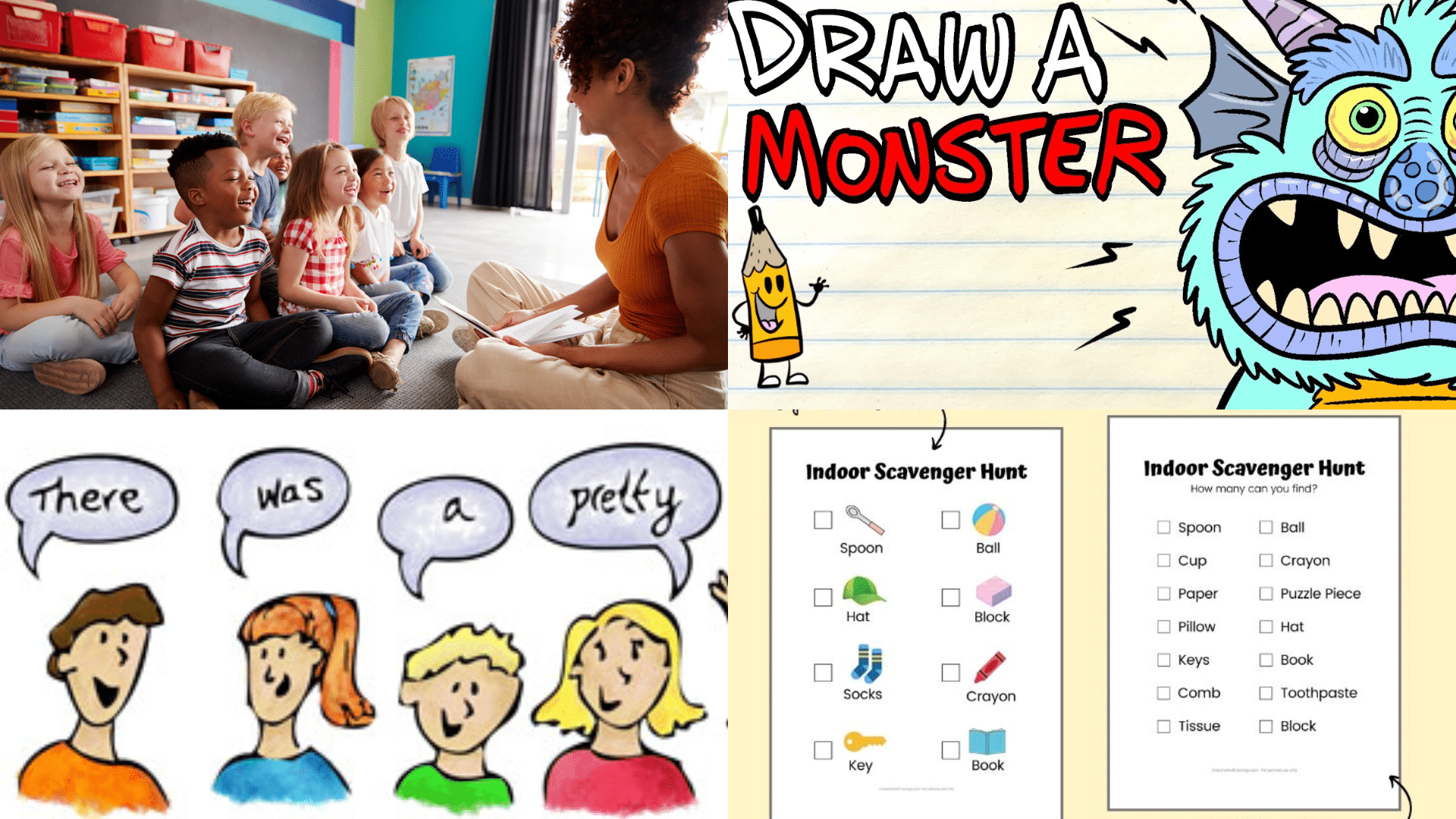
These activities let students show their creative side while learning in a fun way. They mix imagination with practical skills in a low-pressure setting.
19. Interactive Storytime
What it is: A story reading with student participation.
How to play: Read a story aloud and assign parts to students to act out as you read. Students can also make sound effects or repeat key phrases.
Benefits: Makes reading more engaging and builds listening skills.
Materials needed: A story book with lots of action or characters.
Time required: 15-20 minutes.
20. Make a Monster (Draw & Pass)
What it is: A collaborative drawing game with surprise elements.
How to play: Each student draws a monster’s head on paper, folds it to hide most of the drawing, then passes it to the next student, who draws the body without seeing the head, and so on for legs and feet. Unfold to see the funny combinations.
Benefits: Encourages creativity and creates a fun group project.
Materials needed: Paper and drawing materials.
Time required: 15-20 minutes.
21. One Word at a Time (Story Game)
What it is: A group story where each person adds just one word.
How to play: Sit in a circle. The first person says one word to start a story. Moving around the circle, each person adds just one word. The story builds one word at a time.
Benefits: Develops listening skills, quick thinking, and understanding of sentence structure.
Materials needed: None, optional recorder to capture the story.
Time required: 10-15 minutes.
22. Indoor Scavenger Hunt
What it is: A search activity adapted for classroom use.
How to play: Create a list of items or clues for students to find in the classroom. Items can be tied to curriculum (like “Find something that starts with the letter B”) or general classroom objects.
Benefits: Encourages observation skills and can reinforce curriculum concepts.
Materials needed: Scavenger hunt lists.
Time required: 10-15 minutes.
23. Tabletop Obstacle Course
What it is: A miniature obstacle course built on desks.
How to play: Using classroom items like pencils, books, and cups, create a small obstacle course on a desk. Students take turns guiding a marble or small ball through the course.
Benefits: Develops fine motor skills and problem-solving.
Materials needed: Classroom objects, marbles, or small balls.
Time required: 15-20 minutes.
24. Post-It Wall Questions
What it is: An interactive questioning and answering activity.
How to play: Write questions on a board. Students write answers on sticky notes and post them under the relevant questions. Review answers as a group.
Benefits: Allows all students to participate without speaking in front of the class.
Materials needed: Sticky notes, markers, and wall or board space.
Time required: 10-15 minutes.
25. Cup Stacking Relay
What it is: A team game focused on building and taking down cup pyramids.
How to play: Divide students into teams. Teams race to build cup pyramids and then take them down in a specific order. The first team to finish correctly wins.
Benefits: Builds hand-eye coordination, speed, and team cooperation.
Materials needed: Plastic cups (10-15 per team).
Time required: 10-15 minutes.
26. Chair Puzzles
What it is: A problem-solving game using classroom chairs.
How to play: Arrange chairs in a pattern. Challenge students to move the chairs to create a new pattern following specific rules (e.g., “Move only 3 chairs to create a square”).
Benefits: Develops spatial reasoning and problem-solving skills.
Materials needed: Classroom chairs.
Time required: 10-15 minutes.
27. Silent Ball
What it is: A quiet passing game that tests focus and catching skills.
How to play: Students pass a soft ball around the room without speaking. If someone drops the ball or speaks, they sit down. The last student standing wins.
Benefits: Improves focus, catching skills, and self-control.
Materials needed: A Soft ball.
Time required: 5-10 minutes.
Tips for Using These Games in Class
Making these games work well in your classroom takes a bit of planning. The right game at the right time can make a huge difference in how students respond.
- Match games to energy needs: Use active games when students need to move, and calming games when they need to settle down.
- Consider age groups: Adjust rules to make games simpler for younger students or more challenging for older ones.
- Use timers and music: These tools add structure and help students know when activities start and end.
- Set clear rules: Explain all expectations before starting any game to avoid confusion.
- Mix team and individual activities: This gives students chances to work together and also shine on their own.
- Be ready to adapt: If a game isn’t working well, be flexible and modify it on the spot to better fit your class.
Bonus: How to Make Games Inclusive
Creating inclusive games doesn’t have to be complicated. By making simple modifications, you can ensure that students of all abilities can participate meaningfully.
Consider adapting active games with seated variations, such as using colored cards instead of actual chairs for Musical Chairs, or modifying Freeze Dance to focus on freezing arm movements rather than whole-body poses.
Providing choices is another effective strategy. Some students may prefer alternative roles like scorekeeping or being game assistants rather than direct competition. Always respect these preferences and create opportunities for different types of participation.
Clear communication is essential. Use visual aids alongside verbal instructions, demonstrate activities before starting, and break complex games into manageable steps. Take a moment to check for understanding before beginning to ensure everyone feels confident about what to do.
Conclusion
These indoor games can turn slow days into fun learning moments for your class. They help kids build skills while having fun together. You don’t need fancy gear or hours of prep – just pick a game that fits your class mood and watch the magic happen.
Many teachers find that having a mix of games ready for different situations saves them from those tough moments when students get restless.
Try adding one or two new games to your classroom routine each week. Notice which ones your students respond to best and incorporate them into your regular toolkit.
What works in your classroom? Share your ideas in the comments below. Other teachers might find just what they need in your experience.

